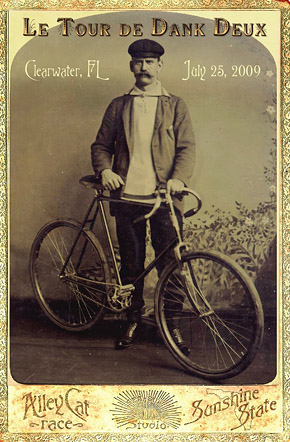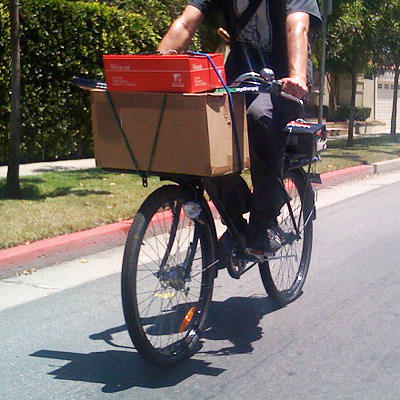 The Kronan Classic we reviewed a few days ago is going to a new home.
The Kronan Classic we reviewed a few days ago is going to a new home.To be honest, your editor hates packing bikes for shipment; and >Kronan USA didn't fancy paying return shipping either. So I put out the word via blog, Twitter, and the local Craigslist, and within a day received a response from none other than the Mighty Josef of Flying Pigeon LA, who had already seen and ridden the bike while I was testing it.
So it will have a happy and productive life as a shop bike at Josef's store, helping sell more cargo bikes to the good folks of Highland Park!
We leave about ten this morning to ride the Kronan over to the Metro station and head northeast.
Glad it's going to such a good home!
Richard Risemberg on Thu, 30 Jul 2009 07:25:12 -0800 [link]
To that end, I am posting the following comments with links to articles and posts covering this matter, and hope you will find plenty of food for thought there, to nourish you for discussions at planning meetings in your own town or city. To wit:
I actually enjoy the occasional "bicycle freeway," assuming it isn't full of strollers, skaters, and wobblers. But overall, bike paths tend to create more intersections with faster motorised traffic, which results in accidents. John forester's Effective Cycling contains many tables showing higher accident rates not only on bikepaths (and sidewalks) but on residential streets compared to arterial boulevards. (Accidents per X miles traveled.) These are charts taken from decades of accident stats gathered by various government agencies and collated by a highly competent engineer, who was also the designer of the "Effective Cycling" courses for street riders. One cannot discuss bike path safety without a knowledge of this body of work.
We have been covering this subject in Bicycle Fixation since 1997. Here are four links to articles by me, Ian Fiddies of Sweden, and Eric Britton of the Carfree Network:
Do We Really Need Bikepaths? (Richard Risemberg)A quote from my ancient article on the matter:
The Safety Paradox (Ian Fiddies)
The Dangers of Cycle Paths (Ian Fiddies)
Lessons Learned in Europe (Eric Britton)
Three major statistical studies have shown that bicyclists on separate bikepaths have an accident rate over two and a half times higher than that of bicyclists on the street. (These studies were commissioned by the AAA, by the CHP, and by a bicycle advocacy group; all three came to the same conclusions. See John Forester's Effective Cycling at your local bookstore or library.)My summation is that bikepaths et al improve safety only belatedly and indirectly, by getting more people on bikes, who eventually start riding in the streets; at that point the increase in social visibility of cyclists improves safety organically. A quote from my article "Safety in Numbers":
A careful British study on bicycle safety found that cyclist traffic deaths were much lower in the 1950s in England even though there was absolutely no bicycle infrastructure of any sort--no bike paths, no bike lanes, nothing but the streets. But cycling accounted for 25% of all travel, so cyclists were everywhere, as a normal part of the street. Whereas now England is full of bike paths and lanes, but cyclists are less safe than they were fifty years ago--because they are few. (However, cycling in Britain is still safer than driving in most other countries!)For a brief description of a segregated bicycle facility that is an absolute deathtrap, see my short blog entry, Lane Brains
Something like the Los Gatos Creek path in San Jose--now, there's room in the world for that, for sure. And the much less charming but also excellent Ballona Creek path. But both are really bicycle freeways, limited-access, just like car freeways.
Richard Risemberg on Sun, 26 Jul 2009 16:45:35 -0800 [link]
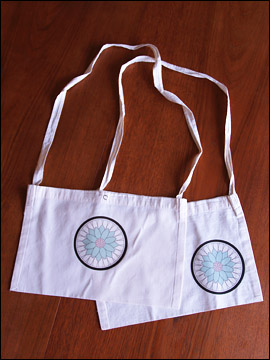 Since Vélo-Rétro had some musettes left in a color that Chuck doesn't prefer, but that we love, we had him print the wheel-and-lotus onto them so we could offer them to our readers. Not really an ad, as there's no text; just our symbol for the harmony that cycling can bring to lifel
Since Vélo-Rétro had some musettes left in a color that Chuck doesn't prefer, but that we love, we had him print the wheel-and-lotus onto them so we could offer them to our readers. Not really an ad, as there's no text; just our symbol for the harmony that cycling can bring to lifelAs you know, we brokered the manufacture of these through the same factory that makes our well-known cycling clothes; they are exact duplicates of a 1950s Italian musette from Chuck's collection, and they fit nicely into a saddlebag or even pants pocket for those moments when you decide to pick up a little gift for spouse, or a pastry to take home from that shop you just discovered during your ride, or to use a daybag for a Sunday spin.
Only $19.99, and there aren't too many of them. Check them out while you can: the Bicycle Fixation Musette!
Richard Risemberg on Sat, 25 Jul 2009 07:39:44 -0800 [link]
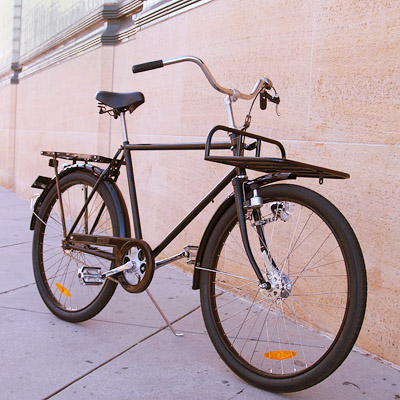 Bicycle Fixation has just posted our review of Kronan's "Classic" city bike, a Eurostyle cruiser for short commutes and cargo runs. We kept it for a month or so and really put it through its paces, as you will see in our review.
Bicycle Fixation has just posted our review of Kronan's "Classic" city bike, a Eurostyle cruiser for short commutes and cargo runs. We kept it for a month or so and really put it through its paces, as you will see in our review.While heavy, this replica of a Swedish army bicycle is bombproof and capable of carrying huge loads with aplomb--at one time I carried Gina on the back, Dutch-style, and a load of groceries, including a watermelon, on the frame-mounted front rack. It proved an excellent box carrier too, as we detail in the story.
It should prove an excellent car-replacement for shopping, dining, and other local activities that take place within two or three miles for most Americans--don't forget that, while US commutes are often long, 40% of car trips here are less than two miles long, and more than half less than three miles, well within the Kronan's "magic circle."
In fact we first saw one at the Larchmont farmers' market right here in car-addicted Los Angeles!
And everyone thinks it's beautiful! Read it and smile: Kronan Classic.
Richard Risemberg on Mon, 20 Jul 2009 08:39:48 -0800 [link]
Nevertheless, that didn't leave time for my preferred trip to the beach, so I headed for the hills instead, with the Bottecchia's tires pumped up nice and fresh and my grungiest grease-monkey shorts on. A nice little spin around Griffith Park would give me some significant hillclimbs to compensate for the lack of distance, and some pretty scenery to make up for the lack of a Pacific Ocean near at hand--and put me right back in Hollywood at the end of the ride, near my former homestead.
I beat the heat up Cahuenga Pass, did the floppy-legged fixie coasting procedure down Barham, and found a slight, warm headwind when I turned onto Forest Lawn Drive. The sky was mostly clear, with a few wispy clouds, and the hills not yet browned by summer (which arrived a bit late again this year), so, aside from too many joggers to dodge in the bike lanes, it was a pretty sweet spin.
I made up for the joggers going through the golf course, where I left the paved road and rolled along the bridle path next to it...figured it would be fun and wouldn't have any fewer joggers to dodge than the roadway!
One more climb--up Los Feliz from Riverside to Vermont, with a lot of rather smelly accompanying car traffic, and I found myself by near my last place of steady employment in East Hollywood, with time for a stop at Sabor y Cultura, my old favorite coffeehouse form the ball-and-chain days. (NB: Their old website was better.) A cup of máte fortified me for scooter fixing, which did not take long, and I headed on home through the leafy environs of Hancock Park.
So, despite having a chore on a Sunday, the bike made it a fine day. And now I'm home waiting for some of Gina's fine cooking to hit the table!
Richard Risemberg on Sun, 19 Jul 2009 13:31:26 -0800 [link]
It's too far for us to go, so we had to content ourselves with sponsoring some of the mayhem by means of Bicycle Fixation schwag, but it sounds like last year was a heap o' fun, and this year might be a heap bigger heap of said fun.
There will be four retro-elegant spokecards too, including the one on this page.
Check out the Tour de Dank Deux MySpace page for details and registration info.
And say Hi to Jeff for us, please....
Richard Risemberg on Mon, 13 Jul 2009 18:02:41 -0800 [link]
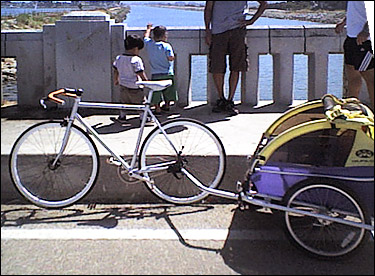 A stunning Southern California day today, warm and clear and clean, with a light breeze, so I rode to the beach for the first time in many weeks. down Jefferson to the Ballona Wetlands, along Pershing past the west end of the airport, then through the hilly beach towns--Manhattan Beach, Hermosa Beach--to the little square at the foot of the Hermosa Beach pier. A pastry and a bit of desultory wandering later, I headed back, this time along the beach bike path, watching the people in their festive ease, and stopped at the Bridge at Playa del Rey, my regular hangout on these rides.
A stunning Southern California day today, warm and clear and clean, with a light breeze, so I rode to the beach for the first time in many weeks. down Jefferson to the Ballona Wetlands, along Pershing past the west end of the airport, then through the hilly beach towns--Manhattan Beach, Hermosa Beach--to the little square at the foot of the Hermosa Beach pier. A pastry and a bit of desultory wandering later, I headed back, this time along the beach bike path, watching the people in their festive ease, and stopped at the Bridge at Playa del Rey, my regular hangout on these rides.That's where I spotted this nice little fixie, complete with extravagant carbon-fiber front brake and big yellow kid trailer behind.
Turns out the rider was Ken Yamakoshi, owner of Parkpre Bicycles, and designer of the fixie too. Not to mention toddler-chaser, as his kid was hilariously active this morning!
A friend of his was with him, riding a CF Parkpre--also with Burley attached!
The fixie, which was stickered "Jaxson," was a nice clean design, with Soma "sparrow" handlebars. (Sorry that the Crappy Cellphone Picture shows so little detail.)
But the sweetest thing was to see a guy who mostly makes dedicated race bikes also involved in a practical bike--and my tens of thousands of miles riding fixed in LA has convinced me that fixies are eminently practical for urban riding.
I don't need a kid trailer--the kid's twenty-three--but it might be nice to have one for hauling wool and inventory around downtown, instead of walking it on a dolly, as I do now!
Richard Risemberg on Sun, 12 Jul 2009 21:55:48 -0800 [link]
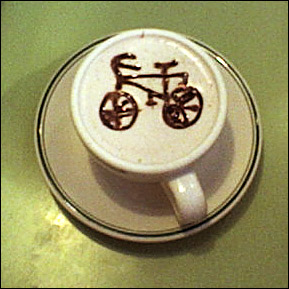 I took the opportunity provided by my promise to deliver Chuck's musettes to South Pasadena to carry them over on the Kronan city/cargo bike I'm road-testing, as I mentioned a few days ago. (I broker the production of the replica race musettes Chuck sells on his wonderful Velo Retro site.) Of course I had a little help from the Metro Rail system, as the Kronan is a more substantial bike than you want to ride on a forty-mile round trip, and more so with a big box on the front rack.
I took the opportunity provided by my promise to deliver Chuck's musettes to South Pasadena to carry them over on the Kronan city/cargo bike I'm road-testing, as I mentioned a few days ago. (I broker the production of the replica race musettes Chuck sells on his wonderful Velo Retro site.) Of course I had a little help from the Metro Rail system, as the Kronan is a more substantial bike than you want to ride on a forty-mile round trip, and more so with a big box on the front rack.But despite the boost from light rail, I needed a bit of refreshment when I arrived at Buster's Coffee to meet Chuck. So I ordered up one of my usual soy hot chocolates and a scone to replace those lost calories.
And the Crappy Cellphone Picture shows you the clever detail Michelle, the barista, added to my cup of hot chocolate!
Really sweetened the day...I can see why Chuck loves South Pasadena so much. (It's a pretty and serene town as well as full of nice folks...and lots of bikes.)
Richard Risemberg on Thu, 09 Jul 2009 21:52:52 -0800 [link]
PORTLAND, Ore. With cycling emerging as the smart, green choice for daily transportation, the need for well-considered, versatile multi-purpose bikes is becoming increasingly relevant. To focus attention on this emerging market, Oregon Manifest, a Portland, Oregon-based organization promoting cycling and cycling lifestyle, has created the first annual Constructor's Design Challenge.And in a few more years, if things go well, Bicycle Fixation may have a design to offer too....
The Constructor's Design Challenge will present bicycle frame builders and designers from around the nation with the opportunity to create an innovative, modern transportation bike--a technical challenge combining engineering dexterity with fabrication mettle. The country's most accomplished makers of hand-built, custom bikes will take up the challenge, including Vanilla from Portland, Igleheart from Wenham, MA., and Independent Fabrication from Somerville, MA. More than 40 builders are expected to field entries.
"The Constructor's Design Challenge is the centerpiece of this year's Oregon Manifest," explained Jocelyn SyCip, Oregon Manifest's Director. "If the bicycle is ever to realize its potential to change the urban transportation landscape--and mindset--it'll take a bike that can multi-task the demands of everyday urban transport. The Constructor's Design Challenge is a unique way to jump start the conversation about what constitutes a great, modern, all-around transportation bike."
Participants in the Constructor's Design Challenge will be faced with building a bike that is flexible, durable, able to portage reasonable loads with ease, and ready to accommodate the many small and large challenges of everyday riding. Transportation bikes must be sturdy and durable, yet nimble enough to provide all-around utility during a short trip or a longer haul.
To prove that the bikes entered in the Constructor's Design Challenge deliver function as well as form, the bikes will compete in a unique real-world transportation test. Presented by Rapha, the UK-based cycling apparel maker, the Constructor's Race will serve up 77 miles of epic on-and-off road challenges inspired by the European one-day classics, such as Paris-Roubaix. Design Challenge builders (or their designated riders) will brave dirt, gravel, elevation climbs, and urban technical trials on the secret, yet-to-be-revealed route.
A specific set of design considerations will govern the Constructor's Design Challenge judging:Response to the Constructor's Race Course : Entry bikes must take into consider all elements of the race course, the 10 design considerations and the overall challenges they present.
- Amazing Solution: Devise a sensational, unique and innovative bike for transportation use.
- Handling: Bikes must handle equally well with and without load. Both options will be tested against turning and straight pedaling.
- Integration: Solutions should be integrated into a complete and harmonious whole, rather than a checklist of details.
- Presentation + Execution: Fabrication refinement and final presentation are important indicators of skill and thoughtfulness. Extraordinary craftsmanship can be displayed in the simplest brazing or the fanciest lug. Individual design solutions should build to a single visual and functional whole.
- Load Carrying: Bikes must accommodate and securely carry the rider's award ceremony party attire, a provided 6-pack of beverage (in glass bottles), and a provided small container of party snacks.
- Security: Since the bikes must be protected from theft while unattended, a smart, easy solution for securing the bike under different conditions is expected.
- Utility: Bikes should handle changing weather, lighting conditions, and visibility.
- Quality + Rattles: If bike components or parts are loose, rattling, or otherwise inoperable at the race finish, points will be deducted for each failure.
- Portage: Bikes must be able to be carried by its rider over a section of the Constructor's Race course.
DETAILS
A prestigious panel of cycling experts will judge the bikes on Friday, October 2nd: Rob Forbes, founder of Design Within Reach; Sky Yaeger, designer of Swobo bicycles; Ron Sutphin, president of United Bicycle Institute; and Brian Bainbridge, former director of R&D for Specialized Bicycles.
The winning builder of the Design Challenge will appropriately earn a fully bespoke suit: a collaboration between Rapha and London tailor Timothy Everest. Constructed for the gentlemen cyclist, the details and design of the suit are equally at home on the bike as the office. See more at: Rapha.
Points will be awarded in the 10 Design Consideration categories listed above, weighted into three points group. Top 12 winners (and the three race winners) will be displayed in the Oregon Manifest Bike Union storefront for five weeks.
All entries will be on display for the public during the Design Challenge weekend. In addition, all participants will be featured in a coffee table book being produced around the event.
If you are interested in entering the Constructor's Design Challenge, visit www.oregonmanifest.com and click on the link to entry forms and regulations. Entry deadline is July 31.
ABOUT OREGON MANIFEST
Oregon Manifest is a 501c4 non-profit organization celebrating the craft and culture of cycling. Their mission is to engage a wide audience with cycling lifestyle through innovative, influential events around the bicycle. Oregon Manifest values the process of making, the spirit of ingenuity and the passion of brave undertakings.
From October 2 to November 8, Oregon Manifest is Portland's unique, multi-faceted celebration of cycling culture, craftsmanship and competition. Expanded to five weeks (up from three days) Oregon Manifest 09 will feature a national bike design challenge, an acclaimed Danish cycling cultural exhibit, two bike races, guest speakers and a pop-up storefront Bike Union--all highlighting the bike's influence on culture, sustainability, climate change, and urban design.
SUPPORTERS OF THE OREGON MANIFEST
Presenting sponsor Chris King Precision Components and the City of Portland have been instrumental in seeding Oregon Manifest. Other key supporters include apparel makers Rapha and Castelli US, Alta Planning + Design, United Bike Institute, BikePortland.org, Cross Crusade, Hopworks Urban Brewery, Oregon Bicycle Constructors Association, the Portland Development Commission, and Travel Portland.
For more information on Oregon Manifest visit www.oregonmanifest.com.
Richard Risemberg on Thu, 09 Jul 2009 16:20:06 -0800 [link]
Still, we may have had to wait till July, but we got a Real Old Fashioned Summer Day at last: by the time our slew of vintage road bikes, fixies, and a plasticine pocket-rocket or two pedaled up the last hill to Beantown, the thermometer on the shaded east wall was nudging 100°F.
Not a day for hot coffee. I had a fruit smoothie, gave myself a case of brain-freeze, and enjoyed a half sandwich before setting off for home.
In the afternoon Gina and I took out the Kronan city bike we're riding to review here in BF, so Gina could photograph it. Camera kit on the front rack, Gina on a home-made cushion on the rear rack! By the time the light faded and we headed home, the temperature had become almost chilly again.
But today is warm, so maybe we'll have a taste of summer after all--in spite of our own collective best efforts to mess things up.
Richard Risemberg on Mon, 06 Jul 2009 15:19:41 -0800 [link]
- Parking is not free; the cost is merely hidden
- The cost of providing a single parking space could be up to $40,000
- By taking up land, parking spots reduce density and make car travel more appealing, which leads to greater demand for parking
- Low-income earners are more likely to carpool, use public transit, walk or cycle, so they are less likely to benefit from the parking they are forced to subsidize
It's also a good companion piece to the Texas DOT's explanation of car subsidies in Do Roads Pay for Themselves? (quoted in CommuteOrlando).
Richard Risemberg on Thu, 02 Jul 2009 08:20:14 -0800 [link]



